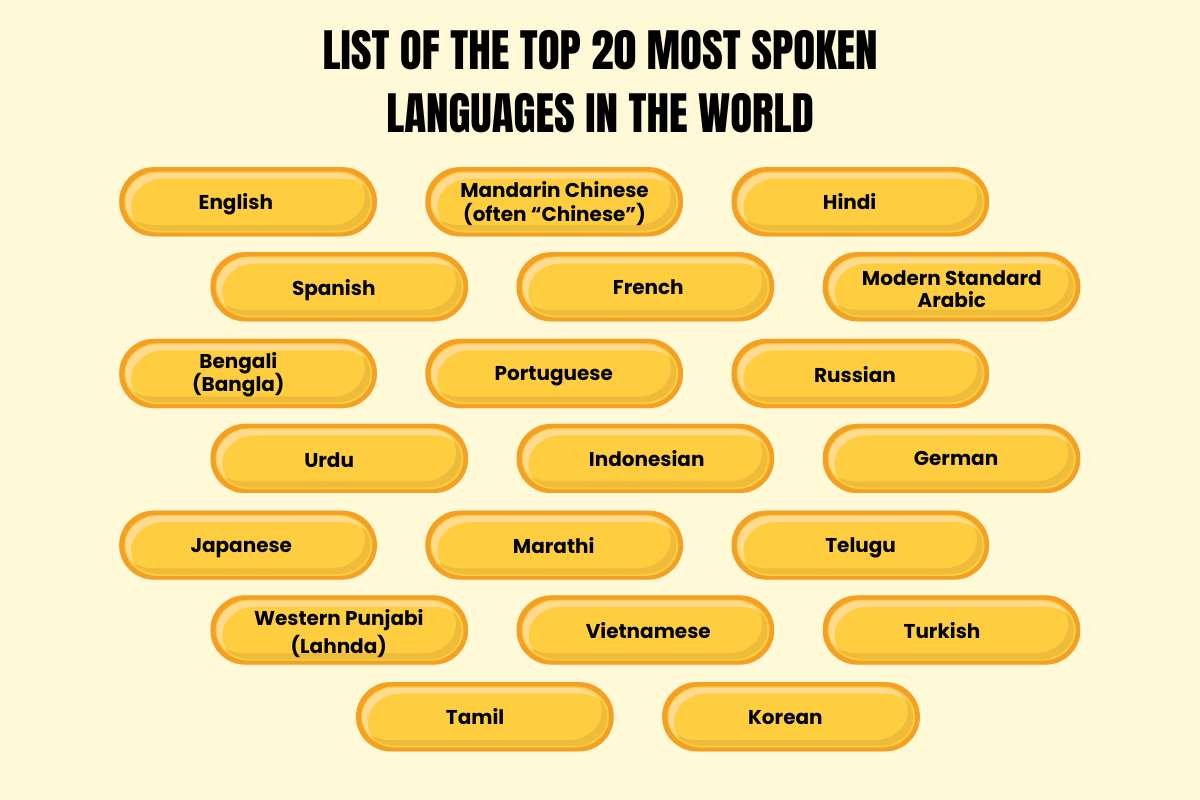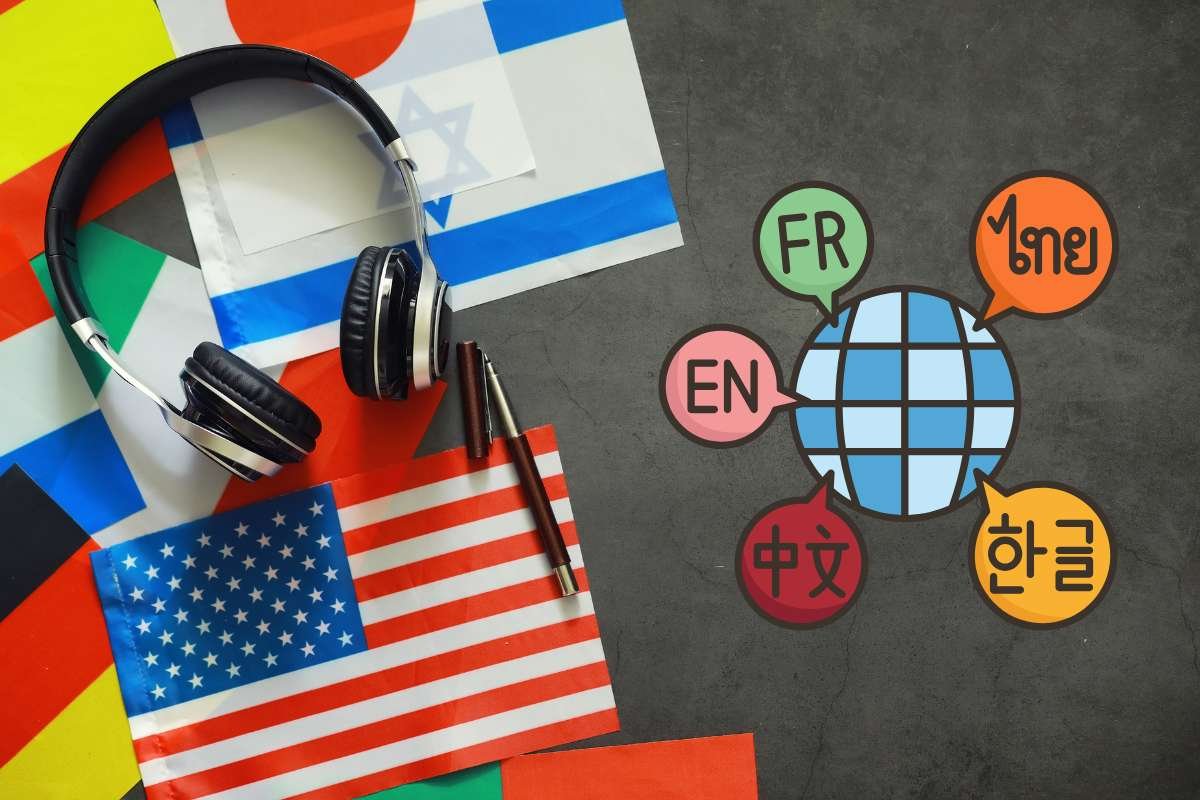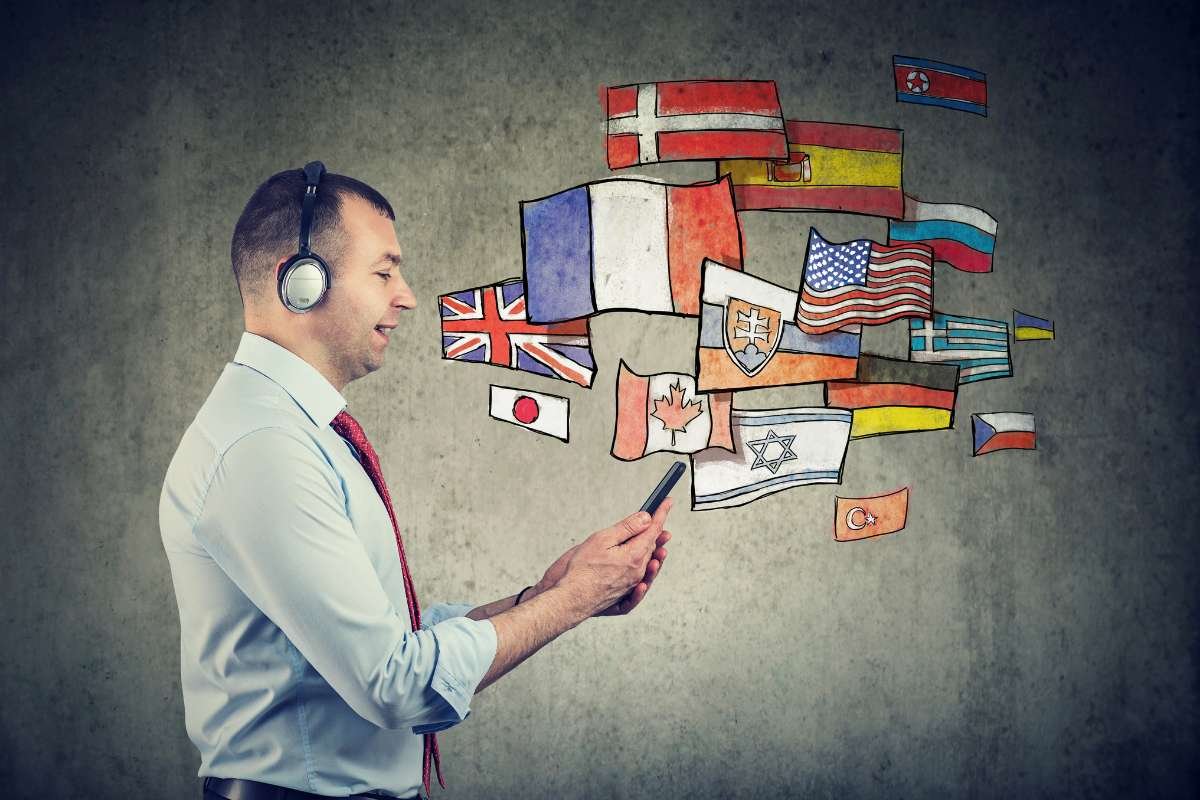A world where everyone speaks the same language. Sounds boring, right?
The beauty of humanity lies in its diversity, and the most spoken languages in the world are proof of that. Every language is a story, a song, a secret handshake between people. Whether you’re ordering chai in Mumbai, bargaining in a Moroccan market, or making memes in English, the most widely spoken languages in the world are your passport to adventure.
They open doors, break barriers, and make the world feel like a giant, friendly neighborhood. So, let’s dive into the world’s most spoken languages and see how they shape our lives, one word at a time.
How to Find the Most Spoken Languages in the World?
Determining the most widely spoken languages in the world involves a few key factors and techniques. Here’s how researchers approach it, in simple terms:
1. Define the metric
- Decide whether to count first-language speakers (native speakers) or total speakers (including people who learned the language later). For example, one language might have fewer native speakers but many second-language speakers.
- Decide whether to count dialects separately or group them. For example, Chinese “dialects” may be grouped under “Mandarin” or treated separately.
2. Use reliable sources
- Refer to large-scale language surveys like Ethnologue or databases like CIA World Factbook.
- Check multiple sources and compare results, since counts vary. As one blog notes: “Determining what are the most spoken languages in the world is a more difficult task than you might imagine.”
3. Consider the second language spread and global influence

- A language may be widely spoken as a second language and thus have significant reach. For example, English has many second-language speakers.
- Also consider how widely the language appears in media, online use, official status, and across countries.
4. Adjust for reliability and time
- Some data may be outdated or collected differently. For instance, counting dialects, changing populations, and migration all affect numbers.
- Use the most recent estimates and clarify whether the figures refer to native or total speakers.
By applying these techniques, you can create a credible ranking of the world’s most spoken languages and understand the logic behind each figure.
List of the Top 20 Most Spoken Languages in the World

Here is a rank-wise descending list of the most widely spoken languages in the world, with language family, estimated total speakers, what they are related to, a fun fact, and a bit of detail. Numbers are approximate and reflect total (native + non-native) where available.
1. English
Family: Indo-European → Germanic branch (West Germanic)
Total speakers: 1.5 billion (native + non-native)
Related to: other Germanic languages (German, Dutch, Swedish)
Fun fact: It’s spoken in about 67 countries officially and often used globally for business and media.
English has become the global language of communication, trade, and technology. It dominates the internet, business, and entertainment industries, appearing in movies, songs, academic papers, and international news. Its spread began through British colonial influence and later expanded through American media, global travel, and education systems. Today, English is often the first or second language people learn to connect with the wider world, making it the true global “bridge language” among the most widely spoken languages in the world.
2. Mandarin Chinese (often “Chinese”)
Family: Sino-Tibetan (Sinitic branch)
Total speakers: 1.1-1.2 billion
Related to: other Chinese varieties (Cantonese, Wu), though mutual intelligibility may vary
Fun fact: Even though its reach outside China is less than English, it has by far the largest number of native speakers.
Mandarin’s strength lies in China’s vast population and growing global influence. It is the official language of China, Taiwan, and one of Singapore’s official languages. It has a complex tone-based system and uses thousands of characters instead of an alphabet, which makes it unique. Its cultural richness and economic importance ensure Mandarin remains one of the most spoken languages in the world. The rise of China’s economy, media, and education abroad has encouraged many non-Chinese speakers to study Mandarin.
3. Hindi
Family: Indo-European → Indo-Aryan branch
Total speakers: 609 million (or more)
Related to: Urdu (shared spoken form), other Indic languages like Bengali, Marathi
Fun fact: Hindi has many dialectal variants and shares roots with Urdu; they are sometimes considered two registers of one language.
Hindi thrives across northern and central India, spoken by millions as a first or second language. Its influence extends through Bollywood films, music, and television that reach global Indian communities. Hindi’s script, Devanagari, is ancient and visually beautiful. It also shares deep roots with Sanskrit, showing India’s long linguistic history. As India’s economy grows and its population expands, Hindi’s global visibility continues to rise, securing its position among the most widely spoken languages in the world.
4. Spanish
Family: Indo-European → Romance branch
Total speakers: 560 million
Related to: Portuguese, Italian, French (other Romance languages)
Fun fact: Spanish is the official language in 21 countries and has 486 million native speakers.
Spanish spread widely during the era of the Spanish Empire, reaching Latin America, the Caribbean, parts of Africa, and the Philippines. Today, it’s spoken across continents, especially in countries like Mexico, Colombia, and Argentina. It’s also the second most studied language in the world after English. From global trade to pop culture, Spanish plays a huge role, keeping it one of the most spoken languages in the world. Its clear pronunciation and musical rhythm make it easy to learn.
5. French
Family: Indo-European → Romance branch
Total speakers: 310-312 million
Related to: other Romance languages like Spanish, Italian, Portuguese
Fun fact: French is the official language in 29 countries and has a strong cultural influence in diplomacy, arts, and cuisine.
France owes its reach to history, diplomacy, and culture. Once the language of royalty and scholars in Europe, it became global through French colonization across Africa, the Caribbean, and Asia. Its timeless influence makes it one of the most spoken languages in the world. It remains an official or second language in many African countries and is used by international organizations like the UN and UNESCO. Known as the “language of love,” French carries cultural prestige in art, cuisine, and fashion.
6. Modern Standard Arabic
Family: Afro-Asiatic → Semitic branch
Total speakers: 274-334 million (varies by source)
Related to: Hebrew, Amharic, other Semitic languages
Fun fact: Arabic includes many regional dialects that can be so different that people might not understand each other, yet they share a formal written form.
Arabic is a unifying language for millions across the Middle East and North Africa. It connects people through religion, as the Quran is written in Classical Arabic, influencing many cultures. Each country, however, has its local dialects, which makes Arabic rich in diversity. Modern Standard Arabic is used in media, government, and education, helping unite the Arabic-speaking world. This mix of cultural, historical, and religious depth ensures Arabic’s strong presence among the world’s most spoken languages.
7. Bengali (Bangla)
Family: Indo-European → Indo-Aryan branch
Total speakers: 270-280 million
Related to: Hindi, Marathi, Assamese
Fun fact: The script and literature of Bengali have a rich history, and it is the official language of Bangladesh and the Indian state of West Bengal.
Bengali stands out for its poetic beauty and emotional depth. It is the national language of Bangladesh and is widely spoken in India’s West Bengal and Tripura states. Bengali literature, especially the works of Nobel laureate Rabindranath Tagore, adds to its prestige. With millions using it daily across South Asia, Bengali continues to grow as one of the most spoken languages in the world. The language has a long literary tradition and plays a major role in the cultural identity of its speakers.
8. Portuguese
Family: Indo-European → Romance branch
Total speakers: 263-264 million
Related to: Spanish, Italian, French
Fun fact: Most Portuguese speakers live in Brazil rather than Portugal; that’s a continental shift.
Details: Portuguese travels far beyond Portugal. Its biggest home is Brazil, which gives the language much of its global presence. It is also spoken in countries like Angola, Mozambique, and parts of Asia due to colonial history. Portuguese has evolved with regional accents and vocabulary differences, especially between Brazil and Portugal. Its use in business, sports, and music (like bossa nova and samba) makes it lively and expressive. With its reach across continents, it remains one of the world’s most widely spoken languages.
9. Russian
Family: Indo-European → Slavic branch
Total speakers: 255-256 million
Related to: Ukrainian, Belarusian, other Slavic languages
Fun fact: Russian uses the Cyrillic script and is one of the official languages of the United Nations.
Russian serves as a key communication tool across Eastern Europe and Central Asia. It’s not only Russia’s official language but also widely used in former Soviet countries like Ukraine, Kazakhstan, and Belarus. Russian literature, science, and space exploration have helped its global reputation. The language’s Cyrillic script and precise grammar give it character and strength. Because of its cultural importance and influence in politics and education, Russian continues to hold a top place among the most common spoken languages in the world.
10. Urdu
Family: Indo-European → Indo-Aryan branch
Total speakers: 238 million
Related to: Hindi (mutually intelligible spoken form), Persian, Arabic influences
Fun fact: Urdu is known for its poetic tradition and beautiful script derived from Persian-Arabic.
Urdu is spoken mainly in Pakistan and parts of India, with large communities worldwide. It is admired for its poetic rhythm, soft sounds, and graceful expressions. Urdu shares much of its grammar and vocabulary with Hindi but is written in a Persian-Arabic script, giving it a distinct identity. Its influence extends through songs, poetry, and media, keeping it alive among both native and non-native speakers. Urdu’s cultural beauty and wide usage earn it a clear spot among the world’s most spoken languages.
11. Indonesian (Bahasa Indonesia)
Family: Austronesian
Total speakers: 199-200 million
Related to: Malay, other Austronesian languages
Fun fact: Indonesian uses a Latin script and is one of the easiest major languages for English speakers to pick up rationally.
Bahasa Indonesia is a unifying language for the diverse Indonesian archipelago, home to hundreds of local dialects. It was chosen as the national language to bring unity after independence. Simple grammar and phonetics make it easy to learn, which helps its spread in education and media. With more than 200 million users, it plays a vital role in connecting a vast multicultural region, making it one of the most spoken languages in the world. Indonesian is also spoken in Malaysia and Singapore in similar forms.
12. German
Family: Indo-European → Germanic branch
Total speakers: 133 million
Related to: Dutch, English, Swedish
Fun fact: German is the most widely spoken native language in the European Union.
German is a language of precision, science, and philosophy. It is widely spoken in Germany, Austria, Switzerland, and parts of Belgium. Its strong influence in engineering, music, and education gives it global respect. Many important scholars and composers, like Einstein and Beethoven, used German, adding to its cultural weight. As Europe’s largest economy, Germany’s trade and technology sectors also help the language spread. These factors together secure German’s place among the world’s most spoken languages.
13. Japanese
Family: Japonic
Total speakers: 123 million native speakers (total slightly higher)
Related to: Ryukyuan languages
Fun fact: Nearly all Japanese speakers live in Japan, which is highly geographically concentrated.
Japanese thrives mainly within Japan, but its cultural reach extends worldwide through technology, anime, gaming, and cuisine. The language combines three writing systems, Hiragana, Katakana, and Kanji, making it complex yet fascinating. Japanese people value politeness, and this is reflected in the language structure itself. Though its speakers are concentrated in one country, Japan’s influence in global business and media keeps the Japanese recognizable and relevant. This cultural power makes it one of the most widely spoken languages in the world.
14. Marathi
Family: Indo-European → Indo-Aryan branch
Total speakers: 83 million native (total may be higher)
Related to: Hindi, Bengali, Gujarati
Fun fact: Marathi is one of the major languages of India’s Maharashtra state, home of Mumbai.
Marathi is the main language of Maharashtra, one of India’s largest and most industrialized states. Its strong regional influence and large number of speakers make it a steady entry among the most spoken languages in the world. Spoken by millions, it’s used in schools, media, and government. Marathi literature is rich, with centuries of poetry, plays, and modern writing. Because Maharashtra includes cities like Mumbai and Pune, Marathi naturally spreads through business, films, and everyday life.
15. Telugu
Family: Dravidian
Total speakers: 83 million native (total may be higher)
Related to: Kannada, Tamil, Malayalam
Fun fact: Telugu is often called the “Italian of the East” for its rhythm and melodious nature.
Telugu is spoken across India’s Andhra Pradesh and Telangana states and has a melodic rhythm that makes it pleasant to hear. It’s one of India’s oldest languages, with a long history of poetry and temple inscriptions. Modern Telugu cinema (Tollywood) helps spread the language globally. Its clear structure and beauty make it beloved among speakers. With millions using it daily in both traditional and modern forms, Telugu remains one of the most widely spoken languages in the world.
16. Western Punjabi (Lahnda)
Family: Indo-European → Indo-Aryan branch
Total speakers: 82 million native (total likely higher)
Related to: Eastern Punjabi, Hindi, Urdu
Fun fact: The Punjabi region spans the India-Pakistan border, and the language shares cultural identity across both countries.
Western Punjabi, also known as Lahnda, is mainly spoken in Pakistan’s Punjab region. It connects deeply with Punjabi culture, which values music, poetry, and community. Although it differs slightly from Eastern Punjabi spoken in India, both share strong linguistic and cultural ties. Its use in songs and folklore keeps it alive among millions. Because Punjab has a large population and rich heritage, Western Punjabi easily earns its rank among the most spoken languages in the world.
17. Vietnamese
Family: Austroasiatic
Total speakers: 85 million native (total may be higher)
Related to: Khmer, Mon, language families of Southeast Asia
Fun fact: Vietnamese uses a Latin-based script developed in the 17th century by Portuguese missionaries.
Vietnamese is the official language of Vietnam and has roots that stretch back thousands of years. It blends native elements with Chinese and French influences, creating a unique sound and vocabulary. Its use of a Latin-based script makes it easier for foreigners to learn. Vietnamese is widely spoken across Vietnam’s growing population and among communities abroad. Its strong identity, modern development, and expanding economy help it maintain a steady spot among the world’s most spoken languages.
18. Turkish
Family: Turkic
Total speakers: 84 million native (total may be higher)
Related to: Azerbaijani, Turkmen, Uzbek
Fun fact: Turkish is written in the Latin script since reforms in the 1920s.
Turkish connects Europe and Asia both geographically and linguistically. After language reforms in the early 20th century, it adopted a Latin script, simplifying writing and boosting literacy. Turkish is not only the national language of Turkey but also spoken in Cyprus and parts of the Balkans. With deep cultural traditions, cuisine, and a rich history, Turkish continues to flourish as one of the most spoken languages in the world. Large Turkish communities in Europe help spread it further.
19. Korean
Family: Koreanic
Total speakers: 82-85 million total (native base 77 million), rough estimate
Related to: Jeju language/dialect
Fun fact: Korean uses the Hangul script, designed in the 15th century, and is one of the most scientific writing systems.
Korea’s influence has skyrocketed thanks to K-pop, K-dramas, and Korean cuisine. It’s the official language of both South and North Korea, with nearly all native speakers living on the peninsula. Hangul, its writing system, is easy to learn and praised for its logical design. Global interest in Korean culture has led millions to study the language worldwide. Its combination of tradition, innovation, and modern entertainment secures Korean’s place among the widely spoken languages in the world.
20. Tamil
Family: Dravidian
Total speakers: 75-80 million native (total may be higher)
Related to: Telugu, Kannada, Malayalam
Fun fact: Tamil is one of the world’s oldest classical languages still in daily use, dating back thousands of years.
Tamil stands out as one of the oldest living languages in the world, with roots tracing back over 2,000 years. It’s the official language of Tamil Nadu (India) and Sri Lanka, with significant communities in Singapore, Malaysia, and beyond. Tamil has a deep literary tradition and a strong emotional bond among its speakers. Modern Tamil films and music also keep the language vibrant. Its historical depth and millions of daily users firmly place Tamil most spoken language in the world.
The Relation Between Language and Culture
Language and culture are like two sides of the same coin. The most spoken languages in the world carry the values, traditions, and stories of their people. For example, Hindi reflects India’s festivals, family bonds, and Bollywood dreams. Arabic is tied to Islamic traditions, poetry, and hospitality. The widely spoken languages in the world shape how people think, act, and connect. They pass down wisdom, humor, and identity from one generation to the next. When you learn a language, you also learn about its culture. The world’s most spoken languages are bridges between hearts and minds.
Transmission of Language and Culture

Language and culture are passed down through families, schools, and communities. The most spoken languages in the world survive because people teach them to their children. Grandparents tell stories, parents sing songs, and teachers share lessons. In many cultures, festivals and rituals are spaces for language learning. The most widely spoken languages in the world thrive when families value their heritage. However, modern life brings challenges. Younger generations often prefer global languages like English. This can make heritage languages fade. The spoken languages in the world need active support to stay alive. Families, schools, and governments all play a role in keeping languages and cultures strong.
Facts and stats related to this blog
- According to a recent Visual Capitalist report, the top languages by total number of speakers include: English (1.5 billion), Mandarin (1.1 billion), Hindi (609 million), and Spanish (559 million).
- According to Britannica, in a list of languages by total number of speakers: English 1,456,448,320; Mandarin Chinese 1,138,222,350; Hindi ~609,454,770; Spanish ~559,078,890; French ~309,804,220.
- According to W3Techs data (March 2025), about web content: English appears in about 49.3% of websites; Spanish about 6.0%.
- According to Ethnologue insights, the list of the top 200 languages ranks English at ~1.5 billion speakers, Mandarin ~1.2 billion, Hindi ~609 million.
These stats reinforce that when we talk about the most spoken languages in the world, we are looking at both sheer numbers and global influence.
Conclusion
The most spoken languages in the world are more than just words; they are the soul of human connection. Just like in our introduction, every language is a story, a song, and a secret handshake. The world’s most spoken languages unite people, cultures, and opportunities. They remind us that diversity is our strength. So, whether you’re learning a new language or celebrating your heritage, remember: the most spoken languages in the world are your passport to adventure, understanding, and belonging.


.jpg)

















